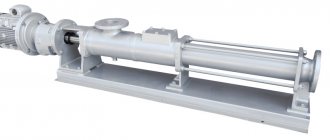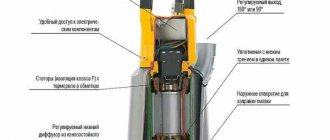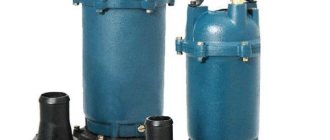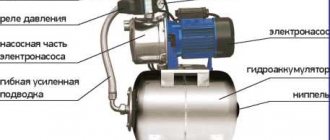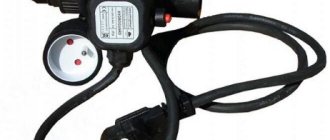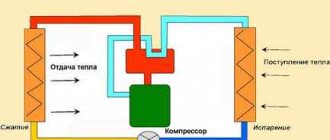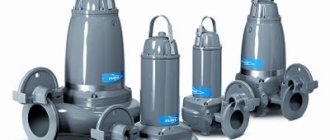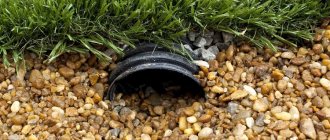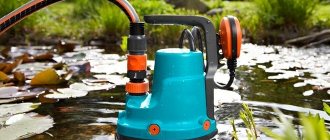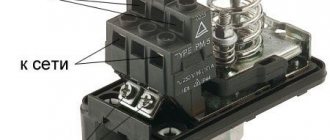Peculiarities
Screw pumps belong to the volumetric rotary gear apparatus. The devices are highly resistant to mechanical loads and aggressive chemicals, which allows them to be used when working with all types of liquids, including polluted and industrial wastewater. The pumps are capable of pumping water and sand without the risk of clogging or failure. Unlike surface models, screw devices require complete immersion under water.
The scope of use of screw pumps is very wide. The devices have found their application in food industry enterprises. They are used to pump viscous substances such as condensed milk and batter. The devices are actively used in gas, oil and artesian wells, when arranging fountains and home water supply, for filling storage tanks and swimming pools.
The units operate at a depth of 8 meters, the rotor rotates at a speed of 6 thousand revolutions per minute, and the fluid pressure at the outlet ranges from 4 to 25 atmospheres, depending on the purpose of the pump and the number of screws.
Screw pumps have a very long service life, high strength and durability. This allows them to be used not only for household needs, but also as pumping equipment at large mining and processing industry facilities. The productivity of the models varies from 1500 to 6000 liters per hour.
Types of screw pumps: submersible and surface pumps
Modifications:
- submersible or deep - placed inside the well on a flexible cable.
- surface boreholes - mounted on the surface of the earth and it is advisable to use them to create pumping stations.
Popular screw pump models:
- Aquarius - used in wells with a passage diameter of at least 100 mm. Available in two modifications - NVP 0.32-32 and NVP 0.32-63. Productivity is about 0.32 x 10 -3m 3/s, pressure is up to 63 meters, weight is 12 and 17 kg.
- Belamos - household models of the 3SP and SP series are produced. All of them have a stainless steel body. Pumps of the 3SP series are designed for supplying water from wells with an internal diameter of 80 mm. Nominal pressure up to 40 meters, productivity up to 1.5 m³/h, cable length no less than 15 m. SP series pumps are designed for individual water supply to dachas and country houses. The diameter of the well is at least 4 inches. Capacity 1.7-1.8 m³/h, pressure 95-150 meters, power cable length 20 m.
- Unipump ECO VINT is available in 3 modifications. One of the best water pumps for a private home - autonomous water supply, watering the garden and summer cottage. Designed for wells with a diameter of at least 85 mm. Pressure up to 90 meters, capacity up to 33 l/min, supplied with a cable 20 meters long. Water is supplied by rotating the working screw in a rubber cage. The absence of a driven screw simplifies pump maintenance and increases its reliability and durability.
- Sprut ZGD is designed for pumping relatively clean water. The pump body is made of cast iron, the screw and drive shaft are made of stainless steel. Mechanical seals are made of ceramographite, motor power is 750 W, productivity is 3.6 m³/h. When combined with a hydraulic accumulator, ZGD is used as a reliable pumping station for uninterrupted water supply to consumers.
Advantages of submersible screw pumps:
- simple and convenient design, allowing easy maintenance and repair;
- the ability to carry out repairs in the field, without the use of special tools and equipment;
- the use of standardized self-clamping couplings, which allow easy dismantling and installation of oil seals and mechanical seals;
- the streamlined body allows you to rotate the suction pipe by 90°;
- the use of electric motors that do not create vibrations, which significantly reduces the generation of acoustic waves and reduces the noise from the pump;
- the use of advanced processing technologies that reduce the cost of pump parts without loss of consumer properties;
- the ability to pump water with various contaminants (sand, dirt, suspended matter) without deteriorating performance characteristics, for example, a submersible mud pump for wells;
- high reliability and durability.
Operating principle and design of a screw pump
In a standard screw household electric pump, the working screw is made in the form of a spiral pin made of corrosion-resistant material, which is chrome-plated steel, stainless steel or high-strength plastic. The liquid sucked in by the rotating screw enters a technical polymer holder and is then pushed out into the upper outlet of the electric pump.
The screw electric pump used in everyday life consists of the following main components (Fig. 7):
1 — Electrical part with a vertically mounted single-phase electric motor with a dry rotor and an oil-filled chamber separating the engine compartment from the hydraulic part; a starting capacitor is located inside the lower part of the housing.
2 — The hydraulic part consists of a housing, a water intake filter and a working auger rotating in a cage made of elastic polymer (rubber) - an assembly of a screw and a rubber coupling pushes the liquid entering the housing through perforated holes 3 to the outlet pipe.
3 — The water intake part is a stainless steel cylinder with holes made in the side walls to draw in water.
4 — On the top cover of the pump, made of brass or stainless steel, there is an outlet pipe and lugs.
5 — The outlet pipe is made with an internal thread with a standard diameter of 1 inch, a check valve and a water-lifting hose are attached to it.
6 – A nylon or metal cable in synthetic protective insulation is tied to the eyes.
Rice. 7 Design of a screw pump
Recommendations for proper installation
In order for a screw pump for a well not to cause problems during operation and to effectively cope with the task of pumping out a liquid medium, it is important to install it correctly. Although the installation of pumping equipment of this type is in many ways similar to the rules for installing centrifugal hydraulic machines, there are certain nuances in this procedure that must be taken into account
Like any other type of submersible pump, screw devices are lowered into a casing installed in a pre-drilled well. To fix the screw pump at a certain depth, a metal cable is used, on which the equipment is suspended in the inside of the casing pipe. The power supply to the pump immersed in the well, as well as the supply of control signals to its automation elements, is provided by a special cable connected to the appropriate terminals.
In cases where high-power pumping equipment is used to equip a well, several cables can be used to connect it to the power supply network and the control unit. The liquid medium pumped out by a screw pump is supplied from the depth of the well to the surface using a powerful hose, the internal diameter of which, depending on the model of equipment used, can be in the range of 25–50 mm.
The screw pump is prepared for immersion into the well
The process of connecting and installing a submersible screw pump is carried out according to the algorithm below.
- The pump that is planned to be lowered into the well is connected to the power supply and started for a short period of time. This is necessary to check the functionality of the device.
- If the pump is functioning normally, then an electrical cable is connected to it, which will be lowered into the well with it.
- A hose is connected to the pressure pipe of the screw pump, through which liquid from the source will be supplied to the surface.
- The hose and the pump power supply cable are tightened together with clamps, and such connections must be made along the entire length of the hose and cable.
- A safety rope is attached to the pump (for this purpose there is a special mounting hole on the hydraulic machine body).
- If a float-type liquid level sensor is supplied with the pump, it must be connected to the equipment.
- The pump, connected to all communications, is carefully lowered into the casing to the required depth. This should be done as carefully as possible so as not to damage the device body when it comes into contact with the pipe walls.
- Once the pump is at the required depth, its position should be secured by tying the upper end of the safety rope to a crossbar mounted on the surface of the ground.
- The upper part of the pressure hose is connected to a pipeline on which a check valve (if it is not included in the design of the hydraulic machine itself), a valve, a pressure gauge and a diverter elbow must first be installed.
- After all connections have been made and the pump is securely fixed in the well at the required depth, a test run is carried out.
The pipe from the casing is removed through the well head along with the supply cable
When test running an installed submersible screw pump, you should pay attention not only to the flow of the liquid medium through the pressure hose, but also to the presence of knocks and vibrations during operation of the equipment. If such phenomena are observed, the screw pump was installed incorrectly
This must be corrected by installing the equipment again according to the above scheme. Unlike submersible centrifugal pumps, screw models do not create vibration during operation. That is why the presence of vibration (and especially knocking) during operation of a screw pump is evidence of its improper installation or malfunction. This requires removing equipment from the well and conducting a thorough diagnosis of its technical condition.
Industrial Application
A screw pump for petroleum products is used for pumping petroleum products without mechanical impurities: oil, petroleum, fuel oil, paraffin, diesel fuel and other liquids that have lubricity.
Sanitary single screw eccentric pumps are used for use in the pharmaceutical, chemical and food industries. Such models have a classic type of equipment with hinged sealed units, ensuring the strength of the unit and ease of maintenance and operation.
There are also screw pumps for highly viscous media. Such media include heavy petroleum products, dough, condensed milk, the already mentioned fuel oil, as well as melts and solutions of polymers. Mono has developed a line of W series pumps specifically for working with them. In addition, the company also offers industrial pumps of the E series, which are additionally capable of pumping abrasive substances.
Today, a sewage pumping station (SPS) with screw pumps is used in a variety of sectors, one of which is wastewater treatment. Self-priming and submersible pumps that are used for these purposes are the most reliable and easy to maintain.
Advantages of screw pumps
- The screw water pump does an excellent job of pumping solid particles without damaging the mechanisms of the device.
- The device is incredibly compact, which allows it to be used in various conditions.
- The pump weighs relatively little, so it is possible to carry it without any extra effort.
- Screw pumps for wells can be suspended on a cable, which makes it easier to operate in certain situations.
- The device works effectively in both vertical and horizontal positions.
- The pump can operate for a long time without interruption.
- The powerful mechanism of screw pumps for wells copes well even with thick silty mixtures. The unit is easy to maintain and repair.
- The pump does not create excess noise even with intense operation, and there is no vibration, which significantly extends the service life of the device.
Submersible ONVP and screw ONF
ONVP submersible pumps are of vertical type. Submersible pumps are used for water and for pumping viscous masses from barrels and other containers. ONF screw pumps would be more correctly called “screw screw pumps”. In addition to the gerotor pair, they have a screw assembly with a rectangular funnel. It is used to supply the product into the receiving cavity of the rotor. Due to this, ONF pumps are capable of pumping difficult-to-flow ingredients with high viscosity, in which the dry matter content can reach up to 18%.
Types and main technical characteristics
Among screw pumps, there are two categories. The fundamental parameter of this separation is the working depth at which these hydraulic machines are capable of operating. So, depending on this characteristic, they distinguish:
- standard screw pumps;
- deep category devices.
A screw pump, belonging to the standard category, is used for pumping water from wells or boreholes whose depth does not exceed 20–25 meters. Such pumps are often used to service wells with low flow rates, drilled in sandy aquifers (sand wells). Since using a screw pump it is possible to pump out a liquid medium with different capacities, while maintaining a stable pressure of the created flow and not paying attention to the content of sand inclusions in the water, this equipment is optimally suited for servicing wells of this type.
Monoblock screw pump with top-mounted water intake
The deep-grade screw well pump is equipped with an extended auger, which determines the impressive technical capabilities of such a hydraulic machine. Possessing high power and reliability, it can successfully service artesian wells, the water in which is located at a depth of up to one hundred meters. Of course, the price of such models is significantly higher than the cost of devices of the standard category, but in many cases, when it is necessary to ensure water supply from wells of considerable depth, such equipment simply cannot be done without.
Let's look at the technical characteristics of a well screw pump belonging to models in the mid-price category:
- productivity, showing how much liquid medium the pump is capable of pumping per unit time, is 1500–2000 l/hour;
- the pressure of the created liquid flow is 40–60 meters of water column;
- the temperature that the pumped liquid medium may have is from +5 to +40°C;
- the size of particles of insoluble solid inclusions that may be contained in the pumped water is 2–2.5 mm;
- The power of the electric motor driving the rotor and auger is 1–1.5 kW.
Sprut range of screw pumps
Most models of mid-price screw pumps, which are often used to equip household autonomous water supply systems, can operate from a 220 V electrical network.
Screw pumps for industrial use have more impressive technical characteristics. In particular, such devices, without compromising their technical condition, can successfully pump liquid media whose temperature significantly exceeds the above values. In addition, industrial screw-type pumps are able to work with liquid media containing insoluble solid inclusions, the particle size of which exceeds 2–2.5 mm.
Borehole screw pump for artesian water intakes
The main part of the body parts of screw-type well pumps is made of stainless steel, individual elements are made of durable plastic. To seal the internal structural elements of such hydraulic machines, gaskets made of rubber and silicone are used.
Since the moving elements of the internal structure of screw pumps are constantly in contact with the pumped liquid medium, they do not require additional cooling.
Design features and purpose
All pumping equipment used to pump water from a well or well can be divided into surface and submersible. Devices of the first category, as their name implies, are installed on the surface of the earth, in close proximity to an underground source of water supply, and the liquid medium pumped by such pumps rises from a well or well through a special pipe. Surface-type borehole pumps are characterized by low pressure levels of the pumped liquid medium, which does not allow their use for servicing wells whose depth exceeds 10 meters.
The same screw that gave rise to the name of the types of pumps in question
During use, submersible pumps are located in the thickness of the pumped liquid medium, remaining in it for the entire period of their operation. Unlike surface pumps, submersible pumps are characterized by significantly higher power: they are capable of creating a pressure of the pumped liquid medium, the value of which amounts to tens of meters of water column (from 50 meters). Such characteristics make it possible to successfully use these hydraulic machines for pumping liquid media from wells that are even very deep.
A screw pump (or spiral pump) is a submersible type device, which means that its body is entirely located in the thickness of the liquid medium it pumps. This well pump received the name “screw” due to the fact that the main element of its design is an Archimedes screw, due to the rotation of which the liquid medium is pumped.
Operating principle of the Archimedes screw
It should be noted that the vast majority of submersible pumps operate not on a screw principle, but on a centrifugal principle. The main working element of centrifugal pumps is a wheel with blades fixed on its outer surface. When such a wheel rotates together with the pumped medium, increased liquid pressure and air rarefaction are created in various parts of the internal working chamber of the pump, which contributes to the pushing of the working medium through the pressure pipe and its suction from the well through the inlet line.
The screw pump, as mentioned above, is equipped with a screw of a certain length, used as the main working element. Due to the fact that the screw mechanism practically does not react to the content of sand and other small solid inclusions in the pumped medium, screw pumps for wells are successfully used to work with liquids characterized by even a significant degree of contamination. The design features of screw mechanisms used to equip submersible screw pumps prevent clogging of the elements that make up such mechanisms by sand contained in the pumped liquid medium.
Schematic illustration of a downhole screw pump
Centrifugal submersible pumps, unlike screw pumps, when pumping a liquid medium with sand, even a fine fraction, quickly fail. That is why, if the question arises of whether a screw or centrifugal pump should be used to pump water even with a small sand content, the choice should definitely be made in favor of screw-type devices.
The operating principle of a screw pump is quite simple:
- Water from the well enters the internal working chamber of the device through the supply hole located in the lower part of its body.
- Captured by the protruding spiral elements of the screw rotating on the rotor shaft, the liquid medium is pushed into the upper part of the working chamber, where the pressure hole is located.
A fairly significant difference between submersible screw pumps and other types of submersible devices is that when the rotation speed of their main working body, the screw, increases, only the productivity of the equipment increases, that is, the amount of liquid medium that it pumps per unit of time.
At the same time, the pressure that characterizes the flow of liquid leaving the pressure line of a screw-type pump remains practically unchanged. This quality of screw pumps for wells allows them to be successfully used even at large industrial facilities. In particular, this equipment is actively used for pumping oil, working with oils and other liquid media for industrial use.
Geometric parameters taken into account when selecting a screw pump
There is a direct relationship between the dimensions (in particular, the length) of the screw with which the screw pump is equipped and the performance of the device. So, the longer the screw electric pump is equipped with a screw, the higher its performance. The vast majority of modern screw-type pumps are equipped with one working screw, and only a small number of models have two or more screws in their design.
The elongated shape of the auger is optimally suited for equipping submersible type pumps with such an element, which are lowered into the casing, and therefore should have the appearance of a cylinder elongated along the longitudinal axis. This form of the main working body of screw pumps makes it possible to create powerful devices based on it, which at the same time have a fairly small diameter.
Screw pumps
These devices are similar to rotary ones. The working element in them is a propeller with blades. The unit is similar to the screw of a meat grinder. When it rotates, water is sucked into the device and supplied under pressure to the outlet pipe.
The advantages and disadvantages of all configurations are the same. They differ only in a few technical characteristics.
Advantages of screw pumps
When deciding which is better - a vortex or centrifugal pump for your water supply system, consider the advantages of units of the first type:
Disadvantages of screw pumps
- Bulky. The difference between a vortex and a centrifugal pump is that the second is much more compact.
- Inability to dose the supplied volume of water.
- Inconveniences during repair and maintenance are due to the fact that all units have a submersible screw. The device will have to be removed from the well, and if it breaks down in winter, this will be problematic.
Pump classification
The number of screw rotors divides the pumps into three types:
- Single screw type pumps;
- Twin screw type pumps;
- Three-screw pumps.
Single Screw Pumps
. Horizontal type pumps, which consist of a single-phase screw and a static rubber race with a two-phase screw surface. The rotation of the screw inside the cage creates cavities into which the pumped liquid enters and then moves along the axis of the screw.
Twin Screw Pumps
. Pumps whose design includes two rotors. The main application of this type of pump is pumping fresh, sea and mineral water.
Three Screw Pumps
. Pumps that are excellent for transferring non-aggressive media without abrasive impurities.
Pumps can also be classified by the number of stages. In addition to single-stage, there are multi-stage screw pumps. They differ from single-screw ones in that they are made of a series of screw turns with a gradually decreasing pitch. The coils are located on a shaft, which, in turn, is placed in a cylindrical pump housing. After each turn there are radial guides for the flow of the pumped substance.
The number of pump stages is one of the important parameters for its selection, since it is determined by what type of liquid is most efficiently pumped using a pump of this design. The right choice allows you to reduce energy consumption and extend the service life of pumping equipment.
Well pump calculation
If the experimental determination of the amount of liquid pumped out by an electric pump does not cause much difficulty, then simple formulas are used to find the required pressure. There are several options for formulas for calculating pressure, one of them looks like this:
H(m) = P x 10.2 + Hb + Np, where
H(m) – determined height of liquid rise in meters;
P – the pressure that must be created in the consumer line, indicated in atmospheres or converted to bars (bar);
Нв – height difference between the suction filter of the electric pump and the consumer line;
Нп – pressure loss due to hydraulic resistance of the pipeline.
Rice. 11 Table for calculating losses in the pipeline
Let's consider choosing a suitable electric pump for a water well using the example of a family of 5 people, to meet their needs a supply volume of about 3 m³/h is required, with a maximum pressure in the system of 3 bar. It is assumed that the height difference is 30 m, and the water main is made of plastic pipe with an internal diameter of 1″ inch (outer diameter 32 mm) for a standard electric pump outlet, its length is 50 meters.
The main difficulty in these calculations is the determination of hydraulic losses in the pipeline. The fact is that they depend not only on the material used to make the pipes, but also on the volume of liquid passing through them, so when calculating, this indicator is easier to determine in accordance with the table in Fig. 11.
The columns contain two rows of numbers; we are only interested in the lower figure indicating losses on a 100-meter section of the pipeline (data are given in meters). For more accurate calculations, the table shows losses in elbows, shut-off valves, tees, and check valves (the required parameter is also indicated in meters).
Let’s assume that our system has one check valve, a tee, a shut-off valve and 3 elbows at an angle of 90 degrees, the total length of losses on which, based on the table, is 12 m.
So, we determine the losses:
Np = (50 + 12) x 11 \ 100 = 6.82 (m)
And we get the general result:
H(m)= 3 x 10.2 + 30 + 6.82 = 67.42 (m)
To determine which pump to choose, let’s use, for example, the table for Grundfos models (Fig. 12). It shows that the modification SQ 3-65 is most suitable for the given pressure and volume of pumping. In the absence of such tables, the electric pump is selected according to pressure characteristics and flow (point 1 in Fig. 13).
Rice. 12 Table for Grundfos pressure characteristics
Selection and maintenance of screw technology
To choose the screw technology that is best suited for the needs of your production, it is worth considering some design features. To decide which device to choose, you should first determine the type of device you need, on which the productivity indicator in cubic meters per hour or liters per minute will depend.
Then determine the required pressure level and height of the liquid column in the area of the pipe, the so-called NPSN indicator. In addition, it is necessary to take into account the chemical composition, density and viscosity, temperature and acid-base balance of the pumped substances. In addition, take into account the amount of abrasives and the possible presence of solid particles in the pumped material.
Three-screw pump design
Well, don’t forget to take into account the voltage and frequency of the power supply network, and the type of transmission mechanism from the motor to the pump. The repair kit included in the equipment list with the most necessary spare parts will be of considerable help.
A screw pump repair kit usually consists of a replacement working screw and a rubber gasket. Therefore, when the auger wears out, you can replace it yourself without having to contact the service department.
Areas of use
Screw technology is used in many areas of industrial production and for domestic needs. Among the main types of screw-type pressure equipment are:
Detailed diagram of a screw pump
- screw pump for water (various variations of a centrifugal pump - vacuum electric pumps, pneumatic screw pump, deep submersible pump);
- food screw pump (milk, oil and fat, confectionery and others);
- devices for the pharmaceutical and chemical industries;
- equipment for the oil and gas and petrochemical industries;
- equipment for power plants;
- equipment for the marine and shipbuilding industry.
An increased level of chemical and mechanical resistance to various non-abrasive inclusions and viscous elements that may be present in the liquid is determined by the elastomeric composition of the stator housing. In addition, it is the composition of the stator housing that determines the maximum permissible temperature range with which screw technology can operate.
For example, in the oil industry, housings are made from NBR elastomer, which can withstand temperatures up to 80 °C. In screw technology for general industrial use, EPDM and HYPALON materials are used, which are able to operate at temperatures up to 120 °C. And in the chemical industry they use FKM type rubber elastomer, which can withstand temperatures up to 150 °C.
Advantage of screw pumps
The ability to pump water with a large number of inclusions is ensured by the special structure of the internal part of the device. To understand how a screw well pump works, it is enough to consider a regular kitchen meat grinder, where the main part - a screw or auger - rotates and moves minced meat or other consistency. In the pump, it is placed in a rubber shell and connected to the engine via a cardan shaft. Devices designed for pumping large volumes have hard shells and can withstand significant pressure. When the shaft rotates, the screw moves, which follows the developed trajectory - the turns of the auger and the rubberized inner surface form cavities that constantly rise to the supply hose or pipe. The liquid moves into the chamber, the pressure forces it to continue moving upward, and areas of rarefaction continue to form in the receiving pipe, which ensures a uniform supply of water from the well.
If you carefully examine the sample (or, again, the meat grinder), you will see that sand or other inclusions have nowhere to get stuck or linger - they rise along with the flow of liquid.
This design provides an undeniable advantage over equipment for moving water of vortex and centrifugal types, since it is screw pumps for wells that extend the life of the water source and ultimately save a significant amount. According to the classification, screw pumps belong to self-priming devices with a multi-stage structure. The developed lines of compact models make even weak wells with a minimum diameter viable.
The choice of optimal equipment is influenced by where it will be installed. For installation in a well, samples that are attached to the wall of the well shaft are suitable. When installing in a well, it is easier - you need a sample with a strong cable. A model designed for standard voltage is suitable for home use.
Operating principle and purpose of the device
The operating principle of each screw unit is based on the movement of liquid along the screw axis inside the chamber. The axis is formed between the surface of the housing and the helical grooves by inserting the helical projections into adjacent grooves. Thanks to this operating principle, a closed space is created inside the device, which does not allow liquid to move back out of the device.
Nowadays, screw pumps are used in many areas of human activity. Most often this equipment is used:
- In food factories - in food production, units are used as dispensers;
- In construction - pumps are used to supply mixtures used for the production of self-leveling floors and roofing;
- At wells, devices pump out contaminated water with a large amount of impurities. A screw well pump can be used both for a source with clean water and for a well with sand;
- In the chemical industry, screw pumps pump large volumes of thick substances for further processing.
High reliability and the ability to operate under high loads make screw pumps one of the most progressive types of pumping equipment.
Recommendations for choosing a pump for a well
Among the various types of pumping equipment used for pumping water from a well or well, submersible devices are the most popular. This popularity is explained by a number of advantages of submersible pumps, which include:
- no noise during operation;
- the ability to ensure uninterrupted water supply from a serviced well;
- ease of installation;
- the ability to provide water supply from wells of considerable depth;
- compact dimensions;
- no need for additional cooling of the drive motor;
- anti-corrosion properties of the materials from which the body is made.
When choosing such a device, you should pay attention to such parameters as:
- the total demand of water intake points for water, which the selected pump must provide;
- characteristics of the well from which water is to be pumped (diameter and depth);
- geological data of the area where the well was drilled (depth at which groundwater is located, soil type, etc.);
- the presence of a power source at the site where it is planned to install pumping equipment.
The main technical characteristics by which pumping equipment is selected are:
- the performance of the device, which characterizes how much liquid it is capable of pumping per unit of time;
- pressure (this parameter, measured in meters of water column, indicates to what height and distance the pump is capable of transporting liquid through the pipeline system).
This approach when choosing pumping equipment will give you the opportunity to further modernize your pumping station if the need arises.
Installing deep-well pumps, as a rule, does not cause any particular difficulties; it can be done even without experience in carrying out such procedures. When operating submersible pumps, as well as any other type of pumping equipment, one should not forget about their regular maintenance, which will significantly extend the life of their trouble-free use.
